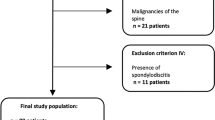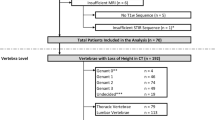Abstract
Purpose
The aim of this study was to evaluate DECT diagnostic accuracy in the identification of vertebral bone marrow edema, using MRI as standard of reference.
Methods
This prospective institutional review board-approved study included 76 consecutive patients (29 males and 47 females; mean age 62.3, range 51–82 years) studied with DECT (90 kV and tin filter 150 kV) and MRI within 7 days. Three radiologists evaluated DECT (reader 1 and 2) and MRI images (reader 3). Diagnostic accuracy of the DECT maps (qualitative assessment) and of the CT numbers (quantitative assessment), interobserver and intraobserver agreements were calculated.
Results
MRI revealed 61 edematous vertebrae and 52 collapsed non-edematous vertebrae. The sensitivity, specificity, PPV and NPV and accuracy of the qualitative assessment of the DECT maps were 88.6, 92.3, 93.1, 87.3 and 90.3%, for reader 1, 90.2, 90.3, 91.6, 88.7 and 90.3, for reader 2, and 91.8, 90.4, 91.6, 90.4 and 91.1% for quantitative analysis, respectively. DECT numbers were significantly different between positive (mean − 23 HU, range − 189, 29 HU) and negative cases (mean − 126 HU, range − 321, − 66 HU) with p < 0.001. The ROC curve analysis revealed an AUC of 0.886 (95% confidence interval 0.722–0.913). The interobserver and intraobserver agreements were near perfect (k = 0.87 and k = 0.83, respectively).
Conclusion
DECT represents an accurate imaging technique for demonstrating bone marrow edema in vertebral compression fracture, if compared to MRI.



Similar content being viewed by others
Abbreviations
- DECT:
-
Dual-energy computed tomography
- MRI:
-
Magnetic resonance imaging
- PPV:
-
Positive predictive value
- NPV:
-
Negative predictive value
- ROC:
-
Receiver operator curve
- AUC:
-
Area under the curve
- TIRM:
-
Turbo inversion-recovery magnitude sequences
References
Bierry G, Venkatasamy A, Kremer S et al (2014) Dual-energy CT in vertebral compression fractures: performance of visual and quantitative analysis for bone marrow edema demonstration with comparison to MRI. Skelet Radiol 43:485–492. https://doi.org/10.1007/s00256-013-1812-3
Gehlbach SH, Bigelow C, Heimisdottir M et al (2000) Recognition of vertebral fracture in a clinical setting. Osteoporos Int J 11:577–582. https://doi.org/10.1007/s001980070078
Papaioannou A, Watts NB, Kendler DL et al (2002) Diagnosis and management of vertebral fractures in elderly adults. Am J Med 113(3):220–228
Karaca L, Yuceler Z, Kantarci M et al (2016) The feasibility of dual-energy CT in differentiation of vertebral compression fractures. Br J Radiol 89(1057):20150300. https://doi.org/10.1259/bjr.20150300
Heini PF, Wälchli B, Berlemann U (2000) Percutaneous transpedicular vertebroplasty with PMMA: operative technique and early results—a prospective study for the treatment of osteoporotic compression fractures. Eur Spine J 9(5):445–450
Klazen CA, Lohle PN, de Vries J et al (2010) Vertebroplasty versus conservative treatment in acute osteoporotic vertebral compression fractures (Vertos II): an open-label randomised trial. Lancet 376(9746):1085–1092
Old JL, Calvert M (2004) Vertebral compression fractures in the elderly. Am Fam Physician 69(1):111–116
Wang CK, Tsai JM, Chuang MT et al (2013) Bone marrow edema in vertebral compression fractures: detection with dual-energy CT. Radiology 269:525–533. https://doi.org/10.1148/radiol.13122577
Tanigawa N, Komemushi A, Kariya S et al (2006) Percutaneous vertebroplasty: relationship between vertebral body bone marrow edema pattern on MR images and initial clinical response. Radiology 239:195–200. https://doi.org/10.1148/radiol.2391050073
Han IH, Chin DK, Kuh SU et al (2009) Magnetic resonance imaging findings of subsequent fractures after vertebroplasty. Neurosurgery 64:740–744. https://doi.org/10.1227/01.NEU.0000339120.41053.F1
Mathis JM, Barr JD, Belkoff SM et al (2001) Percutaneous vertebroplasty: a developing standard of care for vertebral compression fractures. AJNR Am J Neuroradiol 22:373–381
Carberry GA, Pooler BD, Binkley N et al (2013) Unreported vertebral body compression fractures at abdominal multidetector CT. Radiology 268:120–126. https://doi.org/10.1148/radiol.13121632
Frellesen C, Azadegan M, Martin SS et al (2018) Dual-energy computed tomography-based display of bone marrow edema in incidental vertebral compression fractures: diagnostic accuracy and characterization in oncological patients undergoing routine staging computed tomography. Invest Radiol 53(7):409–416. https://doi.org/10.1097/RLI.0000000000000458
Vela JH, Wertz CI, Onstott KL et al (2017) Trauma imaging: a literature review. Radiol Technol 88(3):263–276 (Review)
Karçaaltincaba M, Aktas A (2011) Dual-energy CT revisited with multidetector CT: review of principles and clinical applications. Diagn Interv Radiol 17:181–194. https://doi.org/10.4261/1305-3825.dir.3860-10.0
Johnson TR, Krauss B, Sedlmair M et al (2007) Material differentiation by dual energy CT: initial experience. Eur Radiol 17:1510–1517. https://doi.org/10.1007/s00330-006-0517-6
Magarelli N, De Santis V, Marziali G et al (2018) Application and advantages of monoenergetic reconstruction images for the reduction of metallic artifacts using dual-energy CT in knee and hip prostheses. Radiol Med 123(8):593–600. https://doi.org/10.1007/s11547-018-0881-8
Horat L, Hamie MQ, Huber FA, Guggenberger R (2018) Optimization of monoenergetic extrapolations in dual-energy CT for metal artifact reduction in different body regions and orthopedic implants. Acad Radiol. https://doi.org/10.1016/j.acra.2018.06.008
Guggenberger R, Winklhofer S, Osterhoff G et al (2012) Metallic artefact reduction with monoenergetic dual-energy CT: systematic ex vivo evaluation of posterior spinal fusion implants from various vendors and different spine levels. Eur Radiol 22(11):2357–2364. https://doi.org/10.1007/s00330-012-2501-7
Wortman JR, Uyeda JW, Fulwadhva UP et al (2018) Dual-energy CT for abdominal and pelvic trauma. Radiographics 38(2):586–602. https://doi.org/10.1148/rg.2018170058 (Review)
Petritsch B, Kosmala A, Weng AM, Krauss B, Heidemeier A, Wagner R, Heintel TM, Gassenmaier T, Bley TA (2017) Vertebral compression fractures: third-generation dual-energy CT for detection of bone marrow edema at visual and quantitative analyses. Radiology 284(1):161–168. https://doi.org/10.1148/radiol.2017162165
Kaup M, Wichmann JL, Scholtz JE, Beeres M, Kromen W, Albrecht MH, Lehnert T, Boettcher M, Vogl TJ, Bauer RW (2016) Dual-energy CT-based display of bone marrow edema in osteoporotic vertebral compression fractures: impact on diagnostic accuracy of radiologists with varying levels of experience in correlation to MR imaging. Radiology 280(2):510–519. https://doi.org/10.1148/radiol.2016150472
Genant HK, Wu CY, van Kuijk C, Nevitt MC (1993) Vertebral fracture assessment using a semiquantitative technique. J Bone Miner Res 8(9):1137–1148
Pache G, Bulla S, Baumann T et al (2012) Dose reduction does not affect detection of bone marrow lesions with dual-energy CT virtual noncalcium technique. Acad Radiol 19(12):1539–1545
Author information
Authors and Affiliations
Corresponding author
Ethics declarations
Conflict of interest
The authors declare that they have no conflict of interest.
Ethical approval
All procedures performed in studies involving human participants were in accordance with the ethical standard of the institutional and/or national research committee and with the 1964 Declaration of Helsinki and its later amendments or comparable ethical standard.
Informed consent
Informed consent was obtained from all patients enrolled for this prospective study.
Additional information
Publisher's Note
Springer Nature remains neutral with regard to jurisdictional claims in published maps and institutional affiliations.
Rights and permissions
About this article
Cite this article
Foti, G., Beltramello, A., Catania, M. et al. Diagnostic accuracy of dual-energy CT and virtual non-calcium techniques to evaluate bone marrow edema in vertebral compression fractures. Radiol med 124, 487–494 (2019). https://doi.org/10.1007/s11547-019-00998-x
Received:
Accepted:
Published:
Issue Date:
DOI: https://doi.org/10.1007/s11547-019-00998-x




